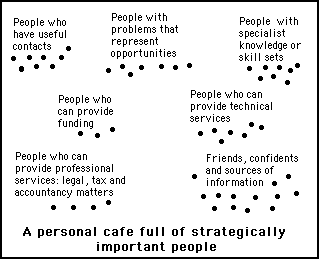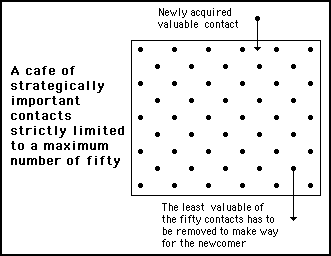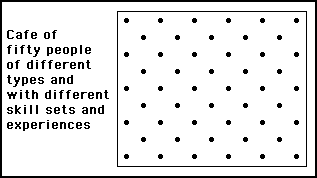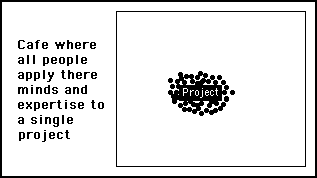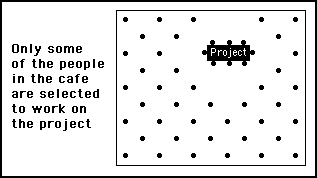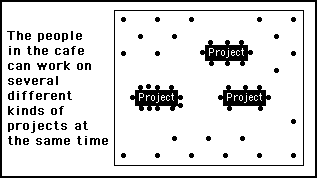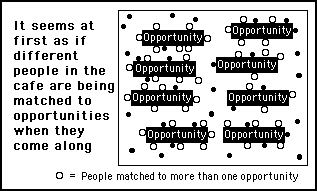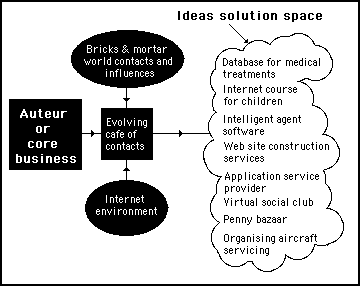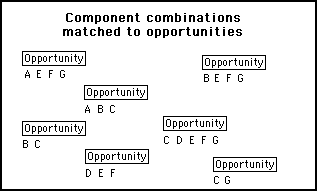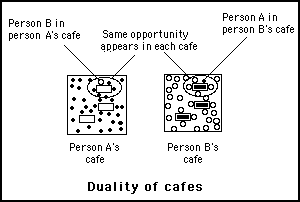Chapter 8
The background to creating an e-business
The uncertainty of an entrepreneurial strategy
By sending each chapter of this book out to readers in the virtual cafe as soon as it is written, I get feedback as to how different people are reacting to the content. At this stage of the book, these opinions and reactions are varying immensely.
Because the stated aim of the book is to create an e-business during the writing, a few are getting impatient because they are expecting me to come up with some great idea where everyone in the cafe will be involved. Some are even waiting to be given detailed instructions as to what to do next. But, it doesn't work that way. Ideas and plans emerge. They are not the starting point in the birth of an e-business.
In a conventional, Industrial Age business environment, businesses can start with ideas and plans because it is possible to make predictions and work with known quantities. Generally speaking, needed assets and services can be bought, hired or loaned because they have a known value. This allows profit sharing by means of employment or work contracts, where the principals take the risks and the hired services or labour can be allocated a fixed amount for their contribution regardless of the success or otherwise of the business outcome.
Businesses associated with risk or uncertain outcomes are usually set up in ways that offset some of the risks to the principals or the investors. Stock options, sales incentives, profit sharing or bonus schemes are introduced. Direct employment is replaced by agencies or affiliate arrangements that pay for results on a commission basis. As a general rule, the higher the risks, the more appropriate it becomes to replace fixed costs by variable costs that are dependent upon actual profits earned.
This is what makes e-businesses so different from Industrial Age businesses. There are so many uncertainties and unknowns, so much unpredictability that there has to be an extremely high proportion of variable costs and a minimum of fixed costs. It is the skill of the auteur or entrepreneur to set up a business in this way.
Planning only works if somebody is willing to finance the plan because it involves instructing people what to do. This is why e-business is not about organisation and control because it doesn't make sense to finance labour in situations where outcomes are unpredictable. With e-business environments so volatile, the game is about the spreading and sharing of risk, rather than the spreading and sharing of profit.
Even when a strategy is concerned with sharing risks, this sharing does not mean gratuitously giving people shares just for taking part. Shares would be offered and taken up only by the people whose contributions would be deemed essential to the success of the business.
At the start of a business, there is nothing tangible to share, all there might be is some vague expectation of a profitable outcome. If everybody had the same expectation and everyone could put in the same effort and each be equally valuable to the business, then a sharing agreement might be possible.
In a high risk, unpredictable situation, the reality is far from this. Everyone would have a different personal assessment as to the risks and possible outcomes. As a consequence, each would contribute with different commitments and enthusiasm. As the direction and the progress of the enterprise is likely to be unpredictable, there is no way of knowing what the value of any single person's future contribution might be. This makes it extremely difficult for auteurs or entrepreneurs to make deals and arrangements because there is no tangible foundation upon which to base share type agreements.
The alternative to agreed sharing is to form alliances, or collaborative associations that are based upon dependencies. These are arrangements where people cannot proceed in a venture without certain vital assets or capabilities that they do not possess themselves. The strategy of the entrepreneur is then a matter of searching for these dependencies and melding them together into some kind of interactive dynamic system, where the dependencies are the glue that hold it all together.
The way this is done cannot be formularised, there can be no rules or guidelines; the exact nature of the system that emerges would be dependent upon what components are available and the combinations that turn out to be compatible. However, as the object of this book is to explain all the stages of creating an e-business from scratch, I have to make an attempt to describe this enigmatic process.
There are three different ways I could approach the writing of this birthing stage of a business:
1) As the description of a strategy I intend to use
2) As the description of a strategy I have used and found successful
3) As a strategy I'm currently using as I write this chapter
I am using the third of these approaches and rationalising the thinking processes as I go along.
The business situation at the start of this chapter
With no specific business idea, no business plan, no management structure and no finance, the situation might seem utterly hopeless. Yet, that is exactly the position I find myself in at the start of writing this chapter.
However, I have three important assets:
1) A Web presence: my personal Web site that explains who I am, what I have done and what I am doing.
2) A virtual cafe, which contains a number of valuable contacts.
3) A conceptual toolbox: a collection of mental models based upon past experiences
With only these three assets, I have to achieve the stated aim of the book, which is to create an e-business before the book is completed.
In fact the situation isn't as hopeless as it might appear to be. The apparent handicap of having no fixed business plan, no management structure and no funding is a distinct advantage at this stage. Freed from the constraints that would normally be imposed upon a conventionally funded business, I am able to use a low cost, low burn rate, freewheeling strategy that allows me to change course and direction at will, switching between opportunities and prospects as events unfold. I have total freedom to use my own discretion and have to account to nobody.
Such freedom is not available to funded businesses or businesses that have sold some of their equity in the Stock Market. They have to maintain a reasonable appearance of order and stability – which burns up capital even when the company is not trading. They have to rationalise their strategies, formalising them into written plans so that decisions can be explained and justified.
Imagine, telling a funding body that you are not sure whether the business is going to be creating a database for medical treatments, developing an Internet course for school children, designing and selling intelligent agent software, providing Web site construction services, building a system of ASPs (application service providers), forming a virtual social club, opening a penny bazaar, organising the servicing of aircraft, or, perhaps something else altogether. They would be tearing their hair out and insisting on bringing in new management. Yet, this is the exact situation I find myself in at the start of writing this chapter. These are the opportunities at hand.
How can such a situation make sense? This chapter is an attempt to provide a rational explanation.
Copying the master strategist
As was explained in the first book of this trilogy – The Entrepreneurial Web – an auteur, or an entrepreneur, might appear to be acting in an irrational manner, but, underlying the apparent randomness and disorder there is usually some kind of abstract model that forms the basis for a rational strategy. These abstract models are not always easily explainable. They are usually generic, seldom relating to any specific business situation.
The advantage of working with these abstract models is that they can be applied to any situation. This is why entrepreneurs are often successful in many different kinds of businesses. They might see openings and opportunities in unfamiliar fields, which have not been recognised by people who have been working in the fields for a long time.
The abstract models I use are based upon the mechanisms that have been devised to explain biological evolution. This may seem utterly bizarre, but, in terms of strategies that deal with uncertainty and competition , Mother Nature is the master strategist of all time. Her strategies for creating viable products and system solutions have proved consistently successful over billions of years. Why look for something different when such a provenly successful model is readily available?
Mother Nature's evolutionary strategy doesn't have any initial ideas or preconceptions. There are no plans or management structures, no rules or protocols. Connectiveness and associations are through chance and necessity. The main goal is to survive and prosper in the face of intense competition, but, isn't this the fundamental goal of all e-businesses?
The key to Mother Nature's success is her strategy's ability to reverse the second law of thermal dynamics. This is the fundamental law of physics, which states that all systems progress relentlessly towards a state of increased entropy. In simple terms, this law is saying that all ordered systems have a tendency to become progressively less ordered and more disorganised.
Mother Nature's way of reversing this law is to create self regulating systems that employ feedback to ruthlessly eliminate all elements that degrade the system and, at the same time, promote the elements that enhance it. It is a blind approach – relying on chance and opportunity – guided only by feedback from results.
It is just such a strategy that will be employed here. The engine to drive this process will be the virtual cafe.
Many ways to use the cafe
The breakthrough in appreciating the full potential of the virtual cafe comes from the realisation that the cafe can be used in many different ways and for many different purposes. As a conceptual tool is is a polymorph, it can be reconceptualised to suit any number of different situations.
In the book "The Ultimate Game of Strategy", it was explained how the concept of the virtual cafe can be used to organise and control a conventional Industrial Age business environment. Executives can use the concept to visualise the various people within their sphere of responsibility as sitting at various tables in a cafe and through the asynchronous nature of e-mail communications appear to be sitting at each table at the same time.
In effect, this would be like the executive spending all the time in various different meetings with everyone in the company but not having to be physically present at any particular time or place. In this way the cafe can be used to create a virtual world, where time can be distorted in ways that would put any science fiction novel to shame.
Also described in "The Ultimate Game of Strategy" was a way in which the virtual cafe can be used to inspire and guide the writing of books. This saw the author sitting at many different tables in a cafe where different groups of readers were commenting upon the chapters as they were written.
As mentioned in chapter 2, the cafe can also be treated as a conceptual framework, to organise personal interactions with various contacts, peer groups, people with complementary knowledge or skill sets. Communications can be structured and organised in the cafe to be optimally efficient for the purpose of enhancing personal capabilities and effectiveness.
Most people's first reaction to the virtual cafe is to think of it in terms of its bricks and mortar counterpart, where it fulfils the purpose of a social meeting place. This would see the cafe as generating business opportunities through rational discussion, mutual agreement and cooperation between the people in the cafe. But, the way the cafe is used involves moving people from table to table, removing them from the cafe altogether if they aren't contributing to the discussions.
Such behaviour would be frowned upon in a real world cafe, but, in a virtual world, it becomes acceptable because the cafe is not the same as its bricks and mortar counterpart, it is in fact an abstract framework for organising personal Internet communications efficiently. Certainly the cafe can be usefully employed to simulate a a conventional cafe with conventional social protocols, but, there are more subtle and powerful ways in which the cafe can be used.
Creating an adaptive cafe of contacts
A virtual cafe simply a list of currently active personal contacts. It will contain people who have become established as confidants, friends, cooperators and collaborators; people who provide reliable information, specialist help or services. It will contain useful contacts who know other useful contacts in many different areas of knowledge and experience. It will contain people who can provide funding, legal help or accountancy services. Most importantly, it will contain people with problems – problems where the solutions might lead to the discovery of profitable business opportunities.
In effect, the virtual cafe is a personal interface to the world at large, a collection of people who would be likely to assist the cafe owner to survive and prosper in a competitive world of high technology and massive connectivity. Such a virtual cafe is illustrated in figure 8.1
Figure 8.1
The cafe as a personal interface to the world
Creating a cafe full of personal contacts has been fully covered in the previous two books in this trilogy. Suffice to say here that the cafe will contain only people whom the cafe owner has built up some kind of special relationship with. As such relationships have to be established over a series of many exchanges that engender mutual trust and credibility, these cafes can take quite some considerable time to build, even in the environment of the Internet.
In theory, it is possible to create personal cafes of any size. But, from a practical and strategic viewpoint it is preferable to limit them to a particular maximum number of contacts. From a practical stand point, is is only possible to maintain continuous and constant personal communication with a finite number of people (in my own cafe, this limit is set at fifty).
By deliberately and specifically limiting the number of contacts in a personal cafe, the cafe can then become an immensely powerful tool because it will facilitate the adoption of Mother Nature's strategy of evolutionary improvement and adaptation.
Consider for a moment the consequence of having a strict limit to the number of people in a personal cafe of contacts. With a strict limit, it becomes mandatory that any newly acquired contact must replace somebody else in the cafe before they can be included – shown graphically in figure 8.2
Figure 8.2
By having a strictly limited number of contacts, new contacts will push out the least valuable. If this in an ongoing process, the quality of the contacts in the cafe will constantly improve and continuously adapt the cafe to changing conditions.
As the people pushed out will be the contacts judged to have the least value (in a current situational sense rather than in absolute terms) the cafe becomes progressively more useful and valuable to the cafe owner. Not only will the quality of the contacts improve, they will also change to suit the changing current needs and interests of the cafe owner – effectively, adapting the cafe to the changing conditions to which the cafe owner is exposed.
This suggests that cafe owners should not confine their communication activity exclusively to the the people inside their cafes. They must allocate a fair proportion of their time to speculative associations in the wider world – looking for fresh contacts. The more effectively they can do this, the faster their cafes will be able to evolve and adapt to changing technology and competitive initiatives.
Using several cafes for different purposes
As the contacts included in a cafe owner's cafe will be there as a result of painstakingly establishing a relationship with each of them, it may seem to be a poor strategy that can dispense with contacts in such a cavalier fashion whenever a more favourable person comes along. But, in fact, they are not dispensed with at all, they are simply moved to another of the cafe owner's cafes – one that covers a different category of relationship.
Remembering that a virtual cafe is just a conceptual device for mentally organising personal communications, there is no reason why a person shouldn't have more than one cafe. Just as people can have one set of friend's for social reason's , another set for a hobby or sporting interest and yet another for business purposes, so a person can have more than one cafe to separate various categories of communication. This is illustrated in figure 8.3.
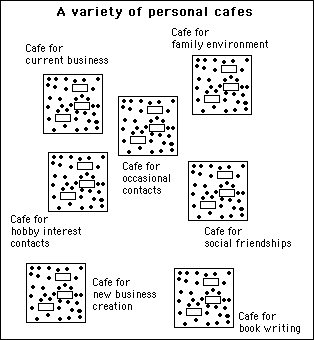
Figure 8.3
A person can have several types of virtual cafes running concurrently, each used to organise communications in a different field of interest
The advantage of working in a virtual world is that you don't have to pigeonhole contacts into any single area of activity. Any contact can be assigned to more than one area of interest. In this cafe metaphor this would mean a cafe owner could assign a contact to more than one cafe. In each cafe, this could be extended even further: to assign a contact to sit at more than one table.
A bricks and mortar world example, of an individual contact who might be placed in more than one category, is when a business colleague is also a social friend or a member of a local sports club. In the different environment there might be totally different relationships. For example, the boss at work may be a player in the local football team where an employee is the team captain. In the two physically and conceptually different settings, there would be a reversal of roles - but this is likely to seem quite natural and acceptable to both parties.
In the environment of the Internet, there are no physical distinctions between different communication environments. This can greatly confuse and interfere with personal Internet relationships, especially where a contact relationship is on several different levels. The simple expedient of dividing contacts into separate conceptual areas – where a single contact can be assigned to more than one area – can greatly improve the efficiency of communication.
Using the concept of cafes to divide personal contacts into different categories is typically characteristic of an object oriented strategy. In each cafe there is a different focus and there is no intermixing of the separate cafe domains. In fact, this principle is not particularly novel because our brain thinks like this anyway. We can instinctively divide our various interests and contacts into various logical groupings and keep them apart.
Unfortunately though, our brain hasn't evolved to deal with the large number of situations and contacts that become available to everyone in the communication environment of the Internet. This is why we need to have computer assistance and conceptual metaphors like the cafe to help us overcome the complexity that can rapidly escalate.
By using a computer to aid mental processing, many different contacts and activities can be arranged in discreet groupings on a screen. This is far more convenient than trying to keep all the relationships and the relative activities in your head and trying to juggle them around in different combinations that have to be remembered – especially where any particular contact or activity might appear in more then one grouping.
With this idea in mind, we can now look at a special kind of conceptual cafe: the kind used to probe and explore the possibilities of creating an e-business from a sea of opportunities.
Using a cafe to explore opportunities
A cafe used to explore new business opportunities in a solution space is conceptually different from a cafe that might be used to write books, accumulate contacts or run an established business. However, the interactions in such a cafe are not easy to explain because so much of the activity is dynamic and in the mind.
Any easily understandable description has to be based around particular incidents or moments in time. This doesn't quite do justice to the fast changing complexity of the many different interactions that occur in the conceptual space of a virtual cafe – where so many thoughts, ideas, approaches, dialogues and actions are continuously being explored and, more often than not, abandoned at an early stage.
Perhaps it is more easily described by way of an animated diagram. Such a diagram emerged out of a correspondence I had with Dr. Thomas Thum, from Munich, Germany. Dr. Thum has an engineering consultancy business that helps companies in the chemical and food processing industries to design and optimise manufacturing and logical processes. His work involves mathematical modelling and the design of simulation software.
In an effort to understand the virtual cafe, Dr. Thum wrote a Java applet that provided an animated demonstration as to how he visualised the cafe working. His first demo is on his Web site at:
http://www.thomas-thum.de/evolutionary_strategy_1.htm.
The essence of this animated simulation is shown in figures 8.4 and 8.5, where the screen opens to a space containing fifty dots to represent people in the cafe.
Figure 8.4
Cafe represented as a space containing fifty dots
Upon clicking a start button, the dots (people) move towards a project with the animation causing the dots to move randomly around in the vicinity of the project to signify the people in the cafe working on the project together. This is illustrated in figure 8.5.
Figure 8.5
Animation simulates all people in the cafe becoming involved in a single project
When I saw Dr. Thum's simulation, I pointed out that the cafe wasn't intended to work this way. Only a few people in the cafe would be involved in any project because they would have been specifically chosen because their particular experiences or skill sets matched the requirements for the project's fulfilment.
Dr. Thum then reprogrammed the simulation (as shown in figure 8.6) to illustrate how just a few of the people in the cafe would become involved in any particular project. The simulation was arranged such that repeated clicking on the "New Project" button would introduce new projects at different places on the screen where different group of the people in the cafe would be attracted towards it.
Figure 8.6
Simulation showing just a few of the people in the cafe would be involved in a project. These would be those whose skills set and knowledge were most appropriate.
When I saw this modification to the animation, I realised that the animation would more accurately reflect the dynamics of the cafe if it showed several different projects being worked on at the same time – with each project attracting a different group of people according their individual suitability and personal interests.
Dr. Thum duly modified the animation, as illustrated in figure 8.7, to show different projects appearing in the cafe space, which would attracted different people in the cafe.
Figure 8.7
Illustrating how the cafe might be involved with several projects simultaneously, with the people in the cafe dividing up to work on different projects according to their capabilities and interests
After seeing Dr. Thum's new modification to the animation, I realised it still wasn't quite reflecting the way in which I was currently using the cafe. Perhaps it might work this way after I had identified and decided upon a few projects to definitely go for, but, at this moment in time I was still only investigating opportunities. The activity in the cafe was mostly in my mind.
Trying to set down on paper, how I was using the cafe to associate different people with different opportunities as they came along, I tried to analyse the mental processes I was using. I visualised how I'd think about who might be interested in working on an opportunity, who would have the necessary skill sets; who might have appropriate and relevant experience or knowledge. I'd look for knowledge gaps, needed skills, snags and pitfalls. I'd think about the possibilities of creating a profitable revenue stream, possibilities of funding; about the competition and possible alternatives.
There is nothing very precise of formal about this mental processing of opportunities. They are just quick assessments made to rapidly eliminate those opportunities that would obviously be non viable or too difficult to handle. I'd be looking for a match between a possible way to take advantage of the opportunity and the capabilities available in the cafe.
Very few of the many possible opportunities that occur pass this initial mental assessment, but, if one does, I identify who in the cafe might be needed to play a key part in bringing about a solution. I'd probably sound one or two of them out first, then, if they agreed on the potential of the opportunity, I'd get them into a discussion around a virtual table to explore the possibility of creating a business that could take advantage of that particular opportunity.
Seen in isolation, these opportunities and discussions can be rationally explained, but, they are not in isolation: many come along together. The activity is mainly instantaneous reactions to ideas and opportunities that seem to come along at random: most of which are quickly postponed or abandoned as flaws or snags were revealed. The more promising ideas or opportunities are investigated and developed further, giving them a longer life with different people involved in different aspects of the opportunities.
Dr Thum then redesigned the simulation to show opportunities coming in and out of existence for varying lengths of time. At each appearance of an opportunity, some of the dots would move towards it. The dots didn't always stay with an opportunity, they might only stay for a short time before moving on to another opportunity, maybe being replaced by other dots.
In this way, Dr. Thum simulated the cafe as a dynamic hive of activity as opportunities come and go and dots flit between them like a swarm of flies. A static illustration of this animation is shown in figure 8.8, but, it does small justice to the real activity that takes place – which goes on mostly in my head and opportunities seldom surviving long enough to involve actual interactive collaboration in the cafe.
Figure 8.8
Illustrating the activity within a virtual cafe as opportunities appear at random. People are shown as being attracted to different opportunities, but, in actuality, much of this action only goes on inside the cafe owner's head as he or she visualises who might be suitable collaborators for any particular opportunity
After this further development of the animated simulation of the cafe, I still felt something was seriously wrong with this model. Something was missing because it still wasn't fully representative of the thinking and the actions I was currently taking in my efforts to create an e-business. What I was doing was involving far less change and mental activity than the model was suggesting. Paradoxically, there was much more stability and simplicity in the cafe I was using, yet, it was producing more complexity.
At the beginning of the chapter, I mentioned all the various e-business possibilities I was currently considering. These included: creating a database for medical treatments, developing an Internet course for school children, designing and selling intelligent agent software, providing Web site construction services, building a system of Asps (application service providers), forming a virtual social club, opening a penny bazaar, organising the servicing of aircraft... and many others besides. The situation can be represented as shown in figure 8.9.
Figure 8.9
The ideas currently being considered at the start of this chapter which will be processed by means of the virtual cafe
Did I really have all these highly complex business possibilities under consideration at the same time? Each in their own right would require the whole of my thinking time, yet, I was seriously considering them all. How was I managing to do this and how was it represented in the animated simulation of the virtual cafe?
It then struck me that it wasn't detailed plans I was contemplating at all. I was considering a relatively small number of conceptual components. These components, in different combinations and applied in different ways, were yielding a large variety of possible scenarios, each of which appeared to be highly complex.
Then I had a thought: reconfiguring a number of basic components? Wasn't this the way Mother Nature created her stupendous array of different life forms? They aren't each individually designed. They are formed out of different combinations of discreet components. At the most basic level these components are genes, viruses and bacteria. These combine and interact in a variety of different ways to produce every life form on the planet. The human form contains something like 100,000 genes. They are not unique to humans, identical genes can be found in all kinds of different animals, even in plants and other kinds of living organisms.
At a level of organisation higher than the genetic level, there are combinations of genes that stay together to provide similar functions or structures in the physiology of a number of different species. These combinations of genes act as more complex components – which Mother Nature is using in different mixes to make all her insects, animals and plants.
From Mother Nature's point of view, she had evolved not complete life forms, but many different components that can be mixed and combined in a multitude of different ways. To her, the components are the more stable elements; the life forms are merely transitional arrangements that have little permanence or long term stability.
This throws a totally new light on the way to create e-businesses. The main concern isn't about looking for smart ideas or problems to solve: the primary objective is to build up a powerful set of components that can be applied to ideas and problems. The components are the main focus. The ideas, problems and opportunities are simply transient possible arrangements for the components at hand.
From this perspective, components must be created before any business ideas can be contemplated because they will determine what kind of e-business opportunity can be seized. To the world at large, this concern with components will seem like dancing around the fire, but, in reality it is the gathering together of a suitably large pool of genetic material.
This realisation also throws a completely different light on the cafe as it is being used to consider possible opportunities for an e-business. It isn't about a a collection of individuals, who have to be instructed what to do. Neither is it about bringing people together to join in a general brain storm to work out solutions to problems. It is about a collection of functions and services being provided by the people in the cafe. These provide conceptual building blocks, concepts from which e-business solutions can be created.
This different way of viewing a virtual cafe – when it is being used to search for a suitable e-business opportunity – is illustrated in figure 8.10.
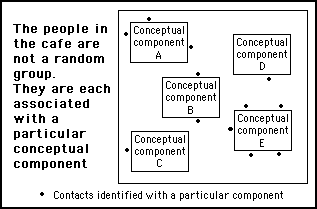
Figure 8.10
The people in the cafe are not there as isolated individuals with particular skills and knowledge. They have been selected because they are associated with the implementation of a particular conceptual component
This make the cafe environment fundamentally different from most conventional business situations; the people in the cafe aren't there to be of service specifically to the auteur. They're there because they provide some essential function in a conceptual component – a component that might be needed in a dynamic system emerging as a response to an opportunity.
The people in the cafe wouldn't have to know how any particular system worked, or, even have to be concerned with its overall purpose. Their inclusion in any newly created system would involve doing little more than they would normally do – which is doing whatever it is they are good at doing.
Combining concepts and the people associated with them together as components allows a system builder to work above the level of technological detail. Although each component might be complex in itself, it can be treated much like a child might treat a component of a Lego set – the pieces can be fitted together to make a construction without having to be concerned about their composition or manufacture.
In this way, a system builder will be free to concentrate upon the overall behaviour of a system, mixing and matching components to quickly construct an e-business solution to any opportunity that presents itself. This is illustrated in figure 8.11, where the letters A, B, C, D, E, F, G represent seven conceptual components that are combined in different ways to provide a variety of solutions to a number of different opportunities.
Figure 8.11
In the mind of the entrepreneur, it is the matching of conceptual components to an opportunity that is the main concern.
What makes a conceptual component?
One of the first hurdles to overcome in using the concept of object oriented design is understanding what constitutes an object. The difficulty arises because of its vagueness: it can literally be anything at all. Even more confusing, an object can consist of other objects, which blurs the idea of an object even further. However, this vagueness is the strength of objects. They can consist of people, software programs, concepts, processing procedures or any combination of these and all kinds of other things.
A conceptual component is an object. It can be a database. More usefully, it can be a person with a database who will provide a database service and do all the necessary work associated with its functioning. In this way the component will provide a function where the user does not have to learn how to use it or have to maintain it.
A component can be a programmer, or, a Web site designer, but, more usefully, it can be a generic Web site design that covers a site owner's needs and comes with somebody who will set it up and handle all the running and future developments of the Web site.
A conceptual component might be a knowledge of bandwidth and load balancing for Web sites. It might be a suite of programs that can be used to optimise the functioning of a Web site. More usefully, such a component will come as an inexpensive service that someone can provide.
Similarly, with a software product. A component can be a programmer who'll create a custom made design. But, far better if the component is an off-the-shelf design that can easily be customised by a service that will be continuously responsible for its efficient performance.
It is such components that will be in the cafes of Information Age auteurs and entrepreneurs who are looking for opportunities to create e-businesses in the post dotcom world. These components will involve no capital outlays or costs until they are profitably used. They are known as FSPs (function service providers) and are a reincarnation of the old concept of Asps (application service providers). We shall be dealing with these FSPs in more detail in a later chapter.
Vital to this object oriented scenario is intangible conceptual components. These are the little mental models that have been abstracted from past experiences. The previous two books in this trilogy were full of these little mental models, mostly consisting of metaphors, similes and anecdotes. These intangible components can be combined in various ways to create a plethora of different organising frameworks for the more tangible components to fit into.
In subsequent chapters we shall be examining how conceptual components and frameworks combine together to explore and take advantage of opportunities, but, before going there, it is vitally important to understand some of the more subtle aspects of bottom up design.
The subtlety of bottom up design
A great problem I had in writing this chapter was in being able to explain the difference between top down and bottom up approaches when it applied to finding and taking advantage of opportunities.
I made several attempts, but, the descriptions of a bottom up approach seemed to come out as just a different way of describing a top down approach. For example, an opportunity opens up to create a solution to a problem. The components in the cafe are examined to see if some mix or combination can provide a solution. Isn't this a classic top down approach, where the requirements of a solution are determined before the components are assembled?
A bottom up approach is about not even knowing what the problem is, let alone knowing the solution. Yet, the idea that you have a solution space full of possible solutions does suggest that you have to start with ideas and opportunities first. Either I was fooling myself about using a bottom up approach, or, some crucial element was missing from my explanation.
This same thought troubled Tillman Pearce, the medical director of an oncology business unit for a large pharmaceutical company in France. Writing to a table of readers in the virtual cafe, he provided an interesting parallel in the medical world:
I have been going over chapters 5 and 6 trying to decide what I think before communicating with the group. I am having difficulties putting things together.
Part of the problem I think we all are having is going back and forth between bottom up and top down thinking. A good figure to use in visualizing this is Figure 7.4. The bottom up is to look at the business assets, skills, and capabilities, and "wait" for the Star Trek type concretization to manifest itself as the right idea. On the other hand, we are all thinking of a good idea to apply our resources to, but, then we are applying a top-down approach.
As I am a physician, I relate this to the process of approaching a patient with an uncertain diagnosis. A good physician switches back and forth between two different modes: he has studied physiology, and the pathology of disease and comes to the bedside with these concepts, or boxes, in which he tries to place the patient's signs and symptoms.
This conceptual approach is obviously necessary as a pattern detection device. On the other hand, it can also blind you to the less than obvious since you risk seeing only what you want to see in order to satisfy the pre-established concepts you brought into the patient's room--- this top down approach works 90% of the time, but obviously depends on how learned is the physician.
A gifted clinician knows how to suspend his judgement and allow his percepts – sight, smell, touch, sound-- to simply observe what is before him. This phenomenological activity of letting things appear as they are is a technique for breaking out of the ruts which your learned concepts place you in – you proceed in this case from the particular (raw sensory inputs, navigation markers) to the general (a diagnosis), i.e., bottom up.
This technique is particularly useful in resolving a difficult diagnosis. However, what usually happens is that all signs and symptoms lead to a seemingly obvious but incorrect diagnosis, yet, a single isolated finding, which doesn't fit the general picture, can lead to discovering a seemingly less likely but more accurate diagnosis. Others discount the anomalies and thus miss the point.
Tillman Pearce
It is just such a similar situation that occurs for cafe owners. Opportunities and ideas are very much like diagnoses: they are possible end solutions. To start with these would necessitate working backwards from them. It would suggest configuring the component's in the cafe to test each possible opportunity or idea to see which of them would provide the best fit for the components in a cafe owner's cafe. This is a top down approach, when what is really needed is a bottom up approach.
The two different approaches to clinical diagnosis as described by Tillman Pearce illustrate perfectly the subtle difference between a top down and a bottom up approach. In the top down approach, an experienced physician knows of a number of possible solutions to the problem of what is wrong with the patient. The symptoms are then used to see which of these solutions provide the best fit to explain what is wrong with the patient.
This can be compared to a cafe owner having many ideas and opportunities and then choosing the idea or opportunity that most closely matches the skills and knowledge available in the cafe. The cafe owner's choices are limited to those that are known.
Tillman Pearce's second physician, on the other hand, doesn't have any preconceived ideas as to what the solution might be. This allows for the possibility that the solution might be outside of all the solutions that he or she is currently aware of. By looking at all the symptoms and concentrating on what symptoms cannot be accounted for, the clinician will be able to look outside of the limited range of the probable to the much wider world of the improbable where a breakthrough solution might be found.
Looking for solutions outside of the probable? Isn't this the way Sherlock Holmes solved his mysteries and didn't the creator of Sherlock Holmes, Arthur Conan Doyle, base this character on an eminent Scottish physician, Dr. Joseph Bell, who was Conan Doyle's professor when he was studying to become a doctor?
Writing in the final decade of the nineteenth century, Dr. Bell, upon whom Sherlock Homes' character was based, commented on Conan Doyle's work and the techniques of detection that had been ascribed to Sherlock Holmes. He wrote:
Dr. Conan Doyle has made a well-deserved success for his detective stories, and made the name of his hero [Sherlock Holmes] beloved by the boys of this country by the marvelous cleverness of his method. He shows how easy it is, if only you can observe, to find out a great deal as to the works and ways of your innocent and unconscious friends, and, by an extension of the same method, to baffle the criminal and lay bare the manner of his crime
Dr. Bell then carried on to explain that the secret of the detections is not simply the observation of detail, but, the ability to relate it to some specialist knowledge. He wrote:
The great broad characteristics which at a glance can be recognised as indicative of heart disease or consumption, chronic drunkenness or long-continued loss of blood, are the common property of the veriest tyro in medicine, while to masters of their art there are myriads of signs eloquent and instructive, but which need the educated eye to detect.
A fair-sized and valuable book has lately been written on the one symptom, the pulse; to any one but a trained physician it seems as much an absurdity as is Sherlock Holmes' immortal treatise on the one hundred and fourteen varieties of tobacco ash. Trained as he has been to notice and appreciate minute detail, Dr. Doyle saw how he could interest his intelligent readers by taking them into his confidence, and showing his mode of working.
He created a shrewd, quick-sighted, inquisitive man, half doctor, half virtuoso, with plenty of spare time, a retentive memory, and perhaps with the best gift of all the power of unloading the mind of all the burden of trying to remember unnecessary details. Holmes tells Watson: "A man should keep his little brain-attic stocked with all the furniture that he is likely to use, as the rest he can put away in the lumber-room of his library, where he can get it if he wants it."
Note: A full version of Dr. Bell's commentary can be found on the Web at:
http://calibercomics.com/SHERLOCK/sherlock_holmes_Dr.%20Bell.htm
Mapping this technique across to a cafe owner who has a solution space: the solution space is not first filled with ideas and opportunities (to see which would be the best fit for the skills and knowledge represented by the people in the cafe). The cafe owner would start with the components in the cafe, playing around with various configurations and then search for ideas and opportunities that would be a suitable match. The ideas and opportunities identified in this way would then be placed into the solution space – for further investigation.
In other words, the cafe owner shouldn't be organising and configuring the people and components in the cafe to provide solutions to known problems: the cafe owner would be starting with the components and looking to find a suitable problem that might be solved by means of this unique mix. The system of components is fixed; it is the ideas and opportunities that have to be changed.
Perhaps this situation is best seen in the way Mother Nature employs this strategy. Mother Nature's equivalent of a cafe full of people and concepts is an ecosystem. When new life forms are introduced into this ecosystem, it is the life forms that have to be compatible with the environment. Mother Nature doesn't reconfigure the environment to cater specifically for new life forms.
This interaction of the life form with the environment may result in them both changing as each adapts to the other, but, the starting point is with the ecosystem – and the kind of life forms that it can sustain.
Why should people collaborate with a cafe owner?
Viewing the activity of a cafe from the cafe owner's perspective, it is easy to forget that any collaborative associations would be dependent upon all parties involved needing to be able to see a substantial personal gain for themselves. After all, everyone in a cafe will have many alternative opportunities and options outside of the cafe environment; any that arise inside of a cafe owner's cafe will have to compete with those.
This may seem obvious, but, what is not so obvious is that a situation seen as a good opportunity by the cafe owner, may not seem such a good opportunity to other people in the cafe whose collaboration is needed by the cafe owner for the opportunity to be taken advantage of. To put it bluntly: "Why should the people in the cafe want to collaborate with the cafe owner? What benefits are on offer that would be preferable to alternative offers of collaboration they might have from elsewhere?".
An answer to this question might be that the cafe owner has a good idea that the others want to be part of. However, this is a top down approach because it necessitates starting with a good idea. The cafe owner then has to convince the others that it is a good idea and because invariably there will be unknowns and uncertainties the reality of the good idea will be on very shaky ground. Almost certainly, it would not be convincing enough for any of the people in the cafe to give their full and whole hearted commitment.
Certainly if the cafe owner obtained funding and ensured that everyone could share in that funding there would be many willing collaborators. But, again this would be a top down approach because to obtain the funding in the first place the cafe owner would have to have had a good idea and a convincing plan that persuaded the funding body to provide the funding. The skill of an entrepreneur is in resolving just this kind of problem.
The clue to resolving such situations is the duality of the cafe concept. To a cafe owner, all the contacts are in his or her cafe. But, to all the people in the cafe, the opportunity appears in their cafe: with the cafe owner being just another person in their cafe. This duality is illustrated in figure 8.12
Figure 8.12
An opportunity identified in one cafe will automatically become present in the cafes of anyone else who is party to it
This duality effect means that once an opportunity is revealed, it appears as an opportunity in all the personal cafes of everyone who is a party to that opportunity. Nobody can thus lay claim exclusively to the ownership of an opportunity once it is revealed.
At first thoughts, this state of affairs might suggest it would be unwise for anyone to reveal an opportunity they had discovered. However, the whole point of having cafes is to arrange collaboration with people who can provide needed assets or resources that a cafe owner is missing. This makes it imperative to reveal an opportunity, to have any chance of securing a collaborative association that will enable an opportunity to be taken.
The appropriate strategy therefore is for anyone who discovers an opportunity to reveal it to those whose assets and resources are complementary to their own and at the same time declare their own assets and resources that would be valuable in taking advantage of the opportunity. Each then (in their own conceptual cafes) might recognise each other as ideal collaborators.
This of course raises the question of trust, but, as explained in the second book in this trilogy, trust in the context of Information Age strategies isn't about loyalty and honesty, it is about trusting people to act sensibly in their own best interests.
If you present an opportunity to someone and they run off to do it without you, it simply means you are playing with a weak hand and deserve to lose. Your position wasn't strong enough to justify yourself as a key collaborator to them. You cannot blame them if they think they can take up the opportunity better without you. You cannot blame them for doing this, anymore than you can blame a poker player for winning a pot with four aces against your four kings. You are just unlucky in that the hand you presented just didn't hold the right cards to win the game.
A sensible entrepreneur will anticipate this situation and will not waste time or effort in presenting opportunities to others when they aren't holding a key position that would be essential for the success of a venture. This is where the concept of the super individual comes into play. Although you might not have all the necessary assets, resources and skills yourself, you might have a suitable collection of contacts that do. This puts you in a position of being a key collaborator who would be vital to the success of a venture.
Of course, you might still get someone who will cut you out just to get a larger share of the pot, but, that would be because they will be playing a zero sum game. You are better off without them and losing to them straight away would be a benefit. After all, opportunities come along very much more frequently than sensible players whom you can rely on to know how to play the game.
Back to index
Note: This book lead to the creation of the stigmergicsystems.com website
### End of chapter 8 ###
Copyright 2001 - Peter Small
Email: peter@petersmall.net
All rights reserved by Pearson Education (Longman, Addison-Wesley,Prentice Hall, Financial Times for FT.COM imprint
